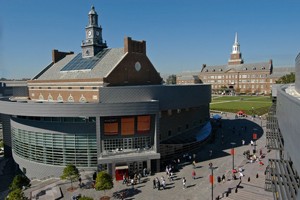
UC's Regional Recruiting Expands to Four New Markets
The Hottest College in America will look toward America's capital and other attractive markets for expanded regional recruitment.
The University of Cincinnati, known by thousands of Twitter users as the #HottestCollegeinAmerica, plans to hire a recruiting representative based in the Washington, D.C., area and to focus additional attention on Atlanta, Dallas-Fort Worth and Detroit.
The new effort builds upon years of
regional recruiting success in the Northeast Ohio and Chicagoland markets
. UC has had recruiting representatives based in Cleveland for about a dozen years and in Chicago for the past two.
UC's Alicia Kornowa, director of admissions recruitment, says recruiting results from existing efforts in those regions bode well for the new areas of emphasis and support her belief that
UC could play well on a much larger recruiting field
.
"Overall our out-of-state freshman applications for Uptown Campus increased 15.3 percent last year compared to the year before. Applications from Chicago increased 25.5 percent in one year, only our second year in the market," Kornowa says. "The rule of thumb is it usually takes three to five years to really develop a market and see the full return on investment."
Increasing enrollment of out-of-state students is one of the ways UC intends to reimagine the student experience and enhance diversity as outlined in
, a university-wide initiative to sharpen the vision of the Academic Master Plan. The Office of Admissions received $131,700 through Third Century to support regional recruiting in the Washington, D.C., area. An additional $175,000 from Third Century will go toward UCs international recruiting efforts.
"We'll follow the model we used with Chicago," Kornowa says. "We're committed to these four additional out-of-state markets for three to five years."
UC is targeting these areas largely based on encouraging demographic analysis. Kornowa and her staff researched multiple resources, including:
- UC applications and alumni networks.
- U.S. Census data.
- IRS migration statistics on where Ohioans move.
- Projections from the Western Interstate Commission for Higher Education, a leading researcher in high school student demographics.
- College Board evaluations on students' out-of-state mobility level, based on where students choose to submit their SAT results.
Put it all together, Kornowa says, and UC has its four primary markets.
"Those stats spoke for themselves. These markets look like the best fit for us," she says.
Next, UC will begin what Kornowa describes as
grassroots-level recruiting in those four markets
. Recruitment representatives will contact school and independent counselors and will reach out to students and their families even offering to meet for a cup of coffee to discuss what UC has to offer.
For Kornowa, it's a method that helps people on both sides of the recruitment process get to know each other and establish trust.
"Recruitment can be very different, especially in the initial years. When we go to a market, we use data and statistics behind the scenes to decide who to reach out to, but then it does become a very grassroots-type of effort. It's really relationship building."
BE A BEARCAT
UC's Office of Admissions can help you find out more about how to
become a University of Cincinnati student
.
Related Stories
University of Cincinnati celebrates DAAP's class of 2024:...
April 27, 2024
Discover the achievements of the University of Cincinnati's College of Design, Architecture, Art, and Planning's Class of 2024 as they graduate into the alumni family, showcasing exceptional talent and innovation. From prestigious awards to prominent job offers, these graduates exemplify the transformative power of creativity and dedication in shaping tomorrow's leaders.
Ancient Maya blessed their ballcourts
April 26, 2024
Using environmental DNA analysis, researchers identified a collection of plants used in ceremonial rituals in the ancient Maya city of Yaxnohcah. The plants, known for their religious associations and medicinal properties, were discovered beneath a plaza floor upon which a ballcourt was built, suggesting the building might have been blessed or consecrated during construction.
UC celebrates record graduating class at commencement
April 26, 2024
UC celebrated the largest spring commencement in its 205-year history during three days of ceremonies at Fifth Third Arena.
